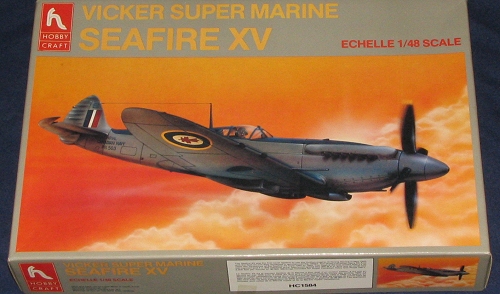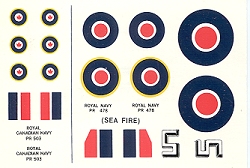
| KIT: | Hobbycraft 1/48 Supermarine Seafire XV |
| KIT #: | HC 1584 |
| PRICE: | $11.98 MSRP |
| DECALS: | Two options |
| REVIEWER: | Scott Van Aken |
| NOTES: | Early Boxing |

| HISTORY |
The Seafire XV started off as the Seafire IV, but was later redesignated before production got underway in late 1944. The first unit to fly the aircraft was 802 Sq which got its Seafire XV's in May of 1945. The aircraft was initially built with the 'A frame' tail hook, but soon switched to the 'stinger' version as this later version prevented the usual 'pitch down' when grabbing the arresting wire. Thanks to engine problems with the Griffon VI, the Seafire XV wasn't cleared for carrier use until early 1947 so it saw no action during WWII. Late Seafire XVs had the cut down fuselage and bubble canopies which made them basically Seafire 17s!
One of the largest users of the Seafire XV was the Canadian Navy who operated the type since June 1945. Of the 384 Seafire XVs built, the RCN had 35, which were turned over to the RCN in 1946 as part of what was owed to Canada by the UK in terms of war claims. The type operated from Canada's aircraft carriers and by training units until 1949 when the type was completely withdrawn from service. Most of these were used for fire-fighting training with only one or two surviving to be restored.
| THE KIT |
 When
Hobbycraft first started producing kits, their main concentration was on
things that were used by Canadian forces. Among that initial batch of kits
was this one on the Seafire XV. The kit itself is molded in medium grey
plastic and consists of one large sprue with most of the small bits on it
as well as two sprues to cover the fuselage and wings and a small clear
sprue with a one-piece canopy and a gun sight. The clear plastic is rather
thick so it is distorted enough to make any real cockpit detailing near
invisible.
When
Hobbycraft first started producing kits, their main concentration was on
things that were used by Canadian forces. Among that initial batch of kits
was this one on the Seafire XV. The kit itself is molded in medium grey
plastic and consists of one large sprue with most of the small bits on it
as well as two sprues to cover the fuselage and wings and a small clear
sprue with a one-piece canopy and a gun sight. The clear plastic is rather
thick so it is distorted enough to make any real cockpit detailing near
invisible.
General detail is good with the engraved detailing being well done. This is marred somewhat by the fact that wherever there is an alignment pin or inside detailing on the wings or fuselage, there is a corresponding sink area on the outer surface. It also seems to this reviewer that the engine 'bumps' on the upper cowling are a bit soft and not as well defined as they could be as well as being a bit short when compared to the drawings in the kit.
Interior detail is fairly well done,
though a tad on the 'chunky' side. A complete floor, bulkheads, seat,
rudder pedals, control stick and instrument panel are provided. The
instrument panel provides instrument faces with no detail. Interior detail
is nicely done with the usual stringers and various black boxes, though it
too is a bit 'chunky'. There is some rudimentary wheel well detail, which I
guess is OK as the Spitfire did not have all the usual wires and tubing
running through the wells as we see on modern aircraft. Wheels are nicely
done, though most will want to replace them with aftermarket. The landing
gear are very basic and basically just tubes. It seems by the oleo scissors
that these may have been molded in the extended position. Replacement of
these would be a big help, but I know of no aftermarket Spitfire landing
gear legs! It also seems to me that the prop blades are a bit short, but I
won't know for sure until after assembly.
after assembly.
Instructions are fairly well done with a nice history, nine well drawn construction steps and two very well done decal and painting guides. Only this last section provides any color information and that is somewhat suspect as they call for FS 34227 for the interior instead of the usual British Interior Green. Two marking options are for a RCN version in Dark Sea Grey over Medium Sea Grey and a British version in Extra Dark Sea Grey over Sky. The decals provide basically roundels and serials. As is typical of early Hobbycraft kits, the decals will probably prove to be useless and mine were a bit off register. Fortunately, we have several aftermarket options so this isn't a real problem.
| CONCLUSIONS |
Since this is an early Hobbycraft kit, it is expected that it will have some problems as that was the norm. However, you are provided with a fairly good basic shape from which to start. Those who just want a generally uncomplicated kit will find it satisfactory while others who have the skills and resources will be able to make a real beauty out of this one. If nothing else, we can thank Hobbycraft for producing a kit of an aircraft that no one else has done in this scale.
| REFERENCES |
Supermarine Aircraft since 1914, Andrews & Morgan, 1987, Naval Institute Press.
The Supermarine Seafire in the Royal Canadian Navy, Leo Pettipas, 1987, self published.
This review kit courtesy of me!
If you would like your product reviewed fairly and quickly by a site that has around 300,000 visitors a month, please contact me or see other details in the Note to Contributors.